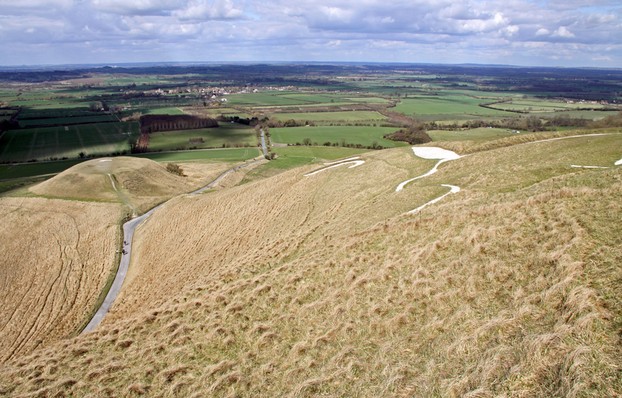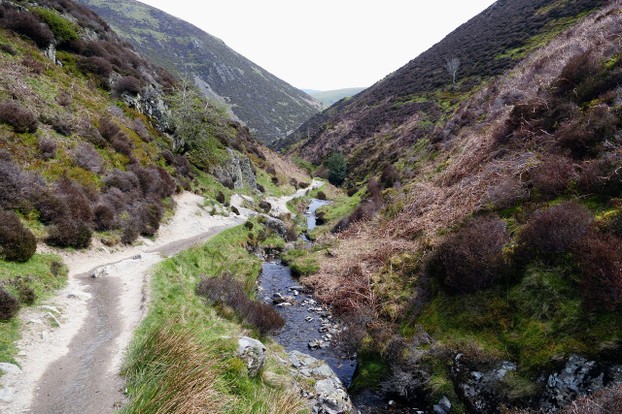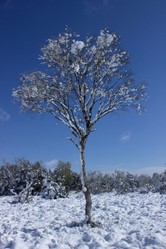Somehow the minister survived the night.
In the morning he climbed out of the ravine, though by that time he had lost all feeling in his fingers and toes. He was by then entering the slopes of Carding Mill Valley, a weavers' setttlement now saved for the public by the National Trust. There was yet another narrow escape, for trudging through the snow he was approaching Light Spout Hollow,a waterfall, and if he had not seen it, the fall down it would have certainly killed him, but he heard the sound of water in time and changed course.
Stumbling through the snow he heard children's voices, so he approached,but then went into a drift upto his neck. Now he was stuck, so he called for help, but the children thought he was a bogeyman [a mythical creature used to scare children into behaving] so they ran away to tell their parents. The parents, however, realized that a man was trapped and set out on a rescue party to dig the Reverend out.
But the people were not rich enough to own transport, so some of them helped the by now barefoot man to walk to the Church Inn in Church Stretton, where the landlord lent him some dry clothes, which were much too large [as the landlord was substantially bigger than the minister] gave him some warm drink and sent for a pony and chaise to take the very relieved minister home to his family, who feared him to be dead. Fortunately, he was advised not to put his frozen fingers or toes into hot water, lest gangrene set in, but to let them thaw gently at their own pace. He followed this advice and made a full recovery. Later on he set down his experiences in a book, A Night in the Snow, which is now out of print and quite rare. I read of his experience in The January Man.
The minister's survival involved inner strength of mind and body, but also the help of others. Without a tough body he would not have lasted the night. Physically strong people have given up and died, so mental strength was needed as well. As a Christian minister he drew on his prayer to mentally strengthen him. But others were needed. Without the good folk of Carding Mill Valley to rescue him he would have died. The rugged individual who lives without the help of others is a delusion, for we are all vulnerable, no matter how physically strong we are.
Related Wizzley article, Walking the Long Mynd







 Pilgrimage. A review17 days ago
Pilgrimage. A review17 days ago
 Leo the Fourteenthon 05/09/2025
Leo the Fourteenthon 05/09/2025
 The Melsonby Hoardon 03/25/2025
The Melsonby Hoardon 03/25/2025



Comments
All villages had people and their resources.
How heartening when a tough-times village becomes a comfortable place!
Did Rattlinghope previously not domicile people- or product-friendly resources?
It is no longer a poverty stricken place, But a comfortable village.
The second paragraph to the first subheading, Snow on the Mynd, alerts us to the "then poor hamlet of Rattlinghope."
Does the aforementioned hamlet no longer deserve a poverty designation?
Thank you for your comment below in answer to my previous observation and question.
Penny Meadow calls to mind the Beatles' Penny Lane.
Does the penny in Penny Lane have the same etymological context as Penny Meadow?
Most would think it has something to do with money.
Thank you for your comment below in answer to my previous observation and question.
So Penny Meadow has no monetary reference! Would most, no, some locals know the meaning as biogeographical or monetary?
As you go north and west Celtic elements become evident. Look at this street in Ashton, in Greater Manchester. Penny Meadow. It derives from pen, meaning high or hill, y meaning the and meadow, an English word. The high meadow. No original pronunciations have been saved and most people are uninterested.
Thank you for your comment below in answer to my previous observation and question.
It fascinates me that non-English names feature in place nomenclature in the British Isles.
Is there an attempt to keep alive the Welsh pronunciation or might there be many Welsh-language keepsakes pronounced with an English accent?
Derdriu, the Long Mynd is in the west of England close to the border with Wales. In these areas west of the River Severn Welsh was spoken until the Eighteenth Century, as the population were basically Welsh people absorbed into England in the Saxon period. . So it is unsurprising that Welsh words such as Mynd survived in place names. For the locals the name means Long Mountain.